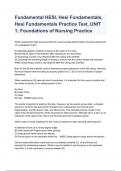Exam (elaborations)
Fundamental HESI, Hesi Fundamentals, Hesi Fundamentals Practice Test, UNIT 1: Foundations of Nursing Practice 2024/2025 graded A+
- Course
- Institution
Fundamental HESI, Hesi Fundamentals, Hesi Fundamentals Practice Test, UNIT 1: Foundations of Nursing Practice 2024/2025 graded A+
[Show more]



